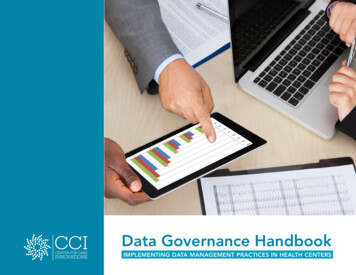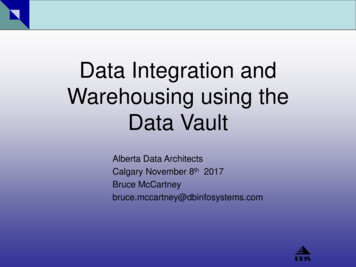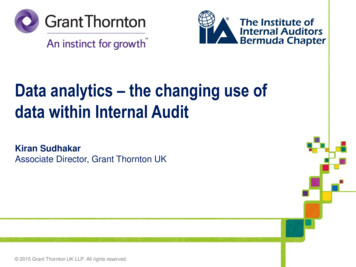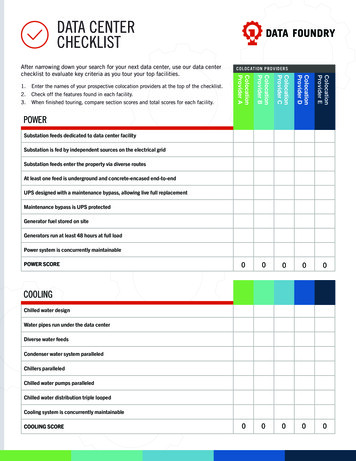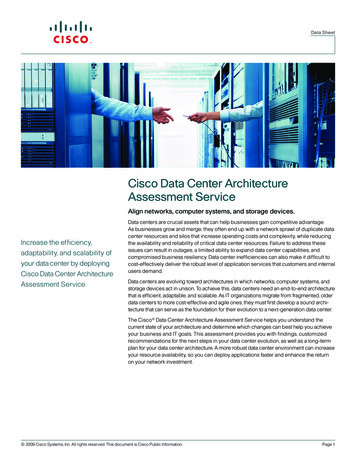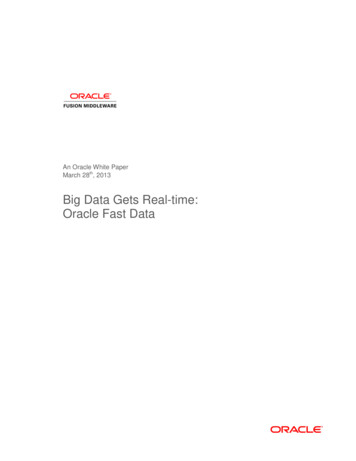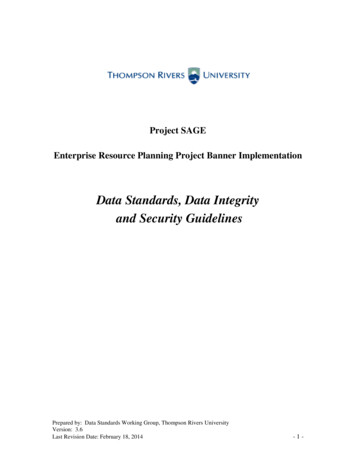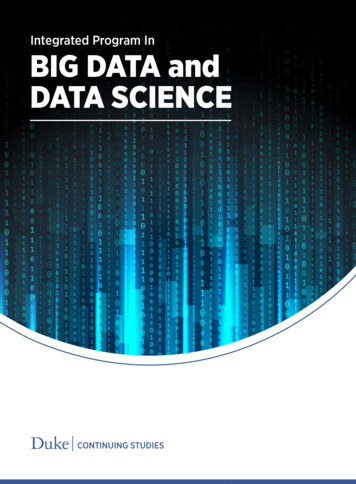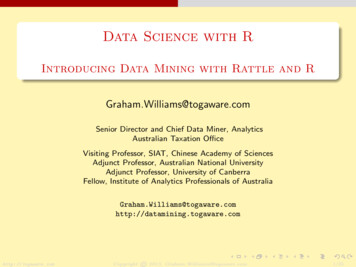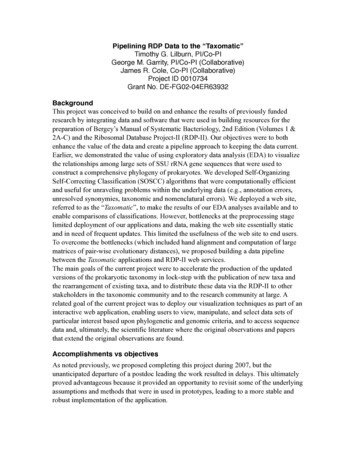
Transcription
Pipelining RDP Data to the “Taxomatic”Timothy G. Lilburn, PI/Co-PIGeorge M. Garrity, PI/Co-PI (Collaborative)James R. Cole, Co-PI (Collaborative)Project ID 0010734Grant No. DE-FG02-04ER63932BackgroundThis project was conceived to build on and enhance the results of previously fundedresearch by integrating data and software that were used in building resources for thepreparation of Bergey’s Manual of Systematic Bacteriology, 2nd Edition (Volumes 1 &2A-C) and the Ribosomal Database Project-II (RDP-II). Our objectives were to bothenhance the value of the data and create a pipeline approach to keeping the data current.Earlier, we demonstrated the value of using exploratory data analysis (EDA) to visualizethe relationships among large sets of SSU rRNA gene sequences that were used toconstruct a comprehensive phylogeny of prokaryotes. We developed Self-OrganizingSelf-Correcting Classification (SOSCC) algorithms that were computationally efficientand useful for unraveling problems within the underlying data (e.g., annotation errors,unresolved synonymies, taxonomic and nomenclatural errors). We deployed a web site,referred to as the “Taxomatic”, to make the results of our EDA analyses available and toenable comparisons of classifications. However, bottlenecks at the preprocessing stagelimited deployment of our applications and data, making the web site essentially staticand in need of frequent updates. This limited the usefulness of the web site to end users.To overcome the bottlenecks (which included hand alignment and computation of largematrices of pair-wise evolutionary distances), we proposed building a data pipelinebetween the Taxomatic applications and RDP-II web services.The main goals of the current project were to accelerate the production of the updatedversions of the prokaryotic taxonomy in lock-step with the publication of new taxa andthe rearrangement of existing taxa, and to distribute these data via the RDP-II to otherstakeholders in the taxonomic community and to the research community at large. Arelated goal of the current project was to deploy our visualization techniques as part of aninteractive web application, enabling users to view, manipulate, and select data sets ofparticular interest based upon phylogenetic and genomic criteria, and to access sequencedata and, ultimately, the scientific literature where the original observations and papersthat extend the original observations are found.Accomplishments vs objectivesAs noted previously, we proposed completing this project during 2007, but theunanticipated departure of a postdoc leading the work resulted in delays. This ultimatelyproved advantageous because it provided an opportunity to revisit some of the underlyingassumptions and methods that were in used in prototypes, leading to a more stable androbust implementation of the application.
Early prototypes of the heatmap visualization tool and classifier, based on the SOSCC,were developed in S-Plus and R. While useful for concept testing, these environmentsproved unsuitable for deploying client applications because of underlying limitations. Were-implemented the SOSCC algorithm as a Java web service and optimized it, addressinga previous limitation that prevented correct placement of some sequences when thealgorithm was run in a fully unsupervised, automated version. Statistical evidence forgroup membership by bootstrapping (currently set to 1000 iterations) within the SOSCCoptimized hierarchy was also added, to provide confidence estimates of groupmembership for each taxon, along with confidence limits of placement in alternativehigher taxa. These data are then fed back into the optimization routine to provide a finalsmoothing of the matrix in which placements with little statistical support are relocated tothe position in the matrix that isbest supported by theMask rowsDatabinary maskexperimental data (Figure 1).These data are then bundledtogether with links to downloadSort rowsthe optimized matrix in dnadistformat and to view the report andRe-order matrixheatmap in the Taxomatic. Therow-wiseimprovements provide a moresatisfactory user experience (e.g.Mask columnsbinary mask30 seconds to produce amaximally smoothed matrix of1000 sequences) and allow theSort columnsentire application to reside on theRDP server(s), where theRe-order matrixinterface is now part of the webcolumn-wiseservices offered by RDP-II.OptimizedtaxonomyThe output of the Taxomatic isshown in Figure 2. DistanceYesmatrices are visualized as heatInputScoring routineApply taxonomymaps and options for accessingtaxonomythe underlying matrix, the imagesArchetypeand the taxonomic informationsequenceselectionare offered. The tool accepts rawdistance matrices or alignedsequence information as dataFigure 1. The revised SOSCC routinesources. When sequenceinformation is provided, thedistance matrix is computed using the uncorrected distance model. Users can upload filesto the Taxomatic website or sequences can be submitted by a SOAP service. This SOAPservice is used by RDP to streamline Taxomatic use with RDP data. In addition to50iterations?No
supplying source information, users can (i) supply their own taxonomic information byuploading it in XML format, (ii) retrieve taxonomic information from the RDP usingeither RDP or Genbank identifiers as source data, with or without classification by theRDP Classifier web service, or (iii) completely omit taxonomic data. In the latter case,the input distance matrix can be viewed in the order in which it was loaded.The SOSCC can now be accessed through the Taxomatic either as a preprocessing optionor as a SOAP service in which a matrix can be reorganized. SOSCC classification can bedone in two ways. A supervised method can be used where an existing taxonomy is fittedto the reorganized matrix or, alternatively, an experimental unsupervised method can beused where boundaries are predicted directly from the resulting matrix. The supervisedclassification method can be bootstrapped to determine the confidence of the placements.Figure 2. A screen shot of the output from the Taxomatic for the phylum Tenericutes.On the left is the heatmap representing the phylogenetic distances among the sequencesthat represent the members of the phylum. In the center is the taxonomy of the phylum.On the right, the data handling flow for the Taxomatic web tool is shown.Dynamic links to NamesforLife information objects, which provide additionalinformation about individual source organisms, their current taxonomic position, andbibliographic information, have been implemented and await a final clean-up of that databy NamesforLife, LLC. Once that task is completed (estimated 3Q 2009), the completetaxonomic hierarchy based on 16S will be rebuilt and published as a new release of theTaxonomic Outline of Bacteria and Archeae (TOBA). This task was originally scheduled
for the latter part of 2008, but is on hold pending resolution of a number of taxonomicand nomenclatural anomalies that have accumulated in the over time.Students associated with this project:Scott Harrison, Microbiology and Molecular Genetics, Michigan State University.Paul Saxman, Medical Informatics Program, University of Michigan State UniversityJordan Fish, Computer Science, Michigan State UniversitySheena Tapo, Microbiology and Molecular Genetics, Michigan State UniversityNicole Osier, Microbiology and Molecular Genetics, Michigan State University.Publications in chronological orderCole, J. R., Q. Wang, E. Cardenas, J. Fish, B. Chai, R. J. Farris, A. S. Kulam-SyedMohideen, D. M. McGarrell, T. Marsh, G. M. Garrity, and J. M. Tiedje. 2009. TheRibosomal Database Project: improved alignments and new tools for rRNA analysis.Nucleic Acids Res. 37 (Database issue): D141-D145; doi: 10.1093/nar/gkn879. [OxfordUniversity Press: 879 ]Lilburn, T.G., S.H. Harrison, J.R. Cole, and G.M. Garrity. 2006. Computational aspectsof systematic biology. Briefings in Bioinformatics 7: 186-195Garrity, G. M. and T. G. Lilburn. 2005. Self-organizing and self-correcting classificationsof biological data. Bioinformatics 21: 2309-2314.Published Abstracts in chronological orderFish, J., Q. Wang, S. H. Harrison, T. G. Lilburn, P. R. Saxman, J. R. Cole, and G. M.Garrity. 2009. Release of the Taxomatic and Refinement of the SOSCC Algorithm,February 8-11, 2009, GTL (Genomes to Life) Awardee Workshop VII, Bethesda,Maryland.Cole, J. R. 2008. Thirty Years of Ribosomal RNA Sequencing, September,20th, SCOPE(Scientific Committee on Problems of the Environment) Workshop presentation,Changsha, China.Cole, J. R. 2008. The Ribosomal Database Project. Max Planck Institute for MarineMicrobiology "International Workshop on Molecular Markers: Ribosomal RNA", April7-9, Max Planck Institute Workshop presentation Bremen, Germany.
Chai, B., Q. Wang, R. Farris, J. Fish, E. Cardenas, A. S. Kulam-Syed-Mohideen, D. M.McGarrell, G. M. Garrity, J. M. Tiedje, J. R. Cole. 2008. Ribosomal Database Project - II:Tools and Sequences for rRNA Analysis. Session 292/R Bioinformatics and Databases;Poster R-122. ASM 108th General Meeting, June 1-5, Boston, Massachusetts.Wang, Q., B. Chai, W. Sul, D. M. Tourlousse, R. C. Penton, A. S. Kulam-Syed-Mohideen,D. M. McGarrell, J. M. Tiedje, J. R. Cole. 2008. A Protocol for Rapid and EfficientBacterial Community Analysis Using Pyrosequencing. Session 175/N MolecularMicrobial Ecology Communities - III; Poster N-203. ASM 108th General Meeting, June1-5, Boston, Massachusetts.Chai, B., Q. Wang, R. Farris, J. Fish, E. Cardenas, A. S. Kulam-Syed-Mohideen, D. M.McGarrell, G. M. Garrity, J. M. Tiedje, J. R. Cole. 2008. Ribosomal Database Project - II:Tools and Sequences for rRNA Analysis. ISME-12 Symposium "Sustaining the BluePlanet", August 17-22, Cairns, Australia.S.H. Harrison, T.G. Lilburn, J.R. Cole, P.R. Saxman, and G.M. Garrity. 2007.Recognizing and Dealing with Taxonomic Distortions Caused By the Wealth of SequenceData. ASM 107th General Meeting, May 21-25, Toronto, Canada.J. Fish, Q. Wang, S.H. Harrison, T. G. Lilburn, P. R. Saxman, J. R. Cole, and G. M.Garrity. 2007. Further refinement and deployment of the SOSCC algorithm as a webservice for automated classification and identification of Bacteria and Archaea. DOEGenomes to Life Contractor and Grantee Workshop, Bethesda, MDHarrison, S.H., P. Saxman, T.G. Lilburn, J.R. Cole, and G.M. Garrity. 2006. PipeliningRDP Data to the Taxomatic and linking to external data. DOE Genomes to LifeContractor and Grantee Workshop, Bethesda, MDGarrity, G.M., C.M. Lyons, J.R. Cole 2006 Knowledge bleed, NamesforLife, andRumsfeld’s axiom. FEMS2006, 2nd Annual Meeting Federation of EuropeanMicrobiology Societies. Symposium on Biodiversity, Madrid, SpainLilburn, T. G., Y. Bai, Y. Zhang, J. R. Cole and G. M. Garrity. 2005. Projections, trees andevolutionary space. For the XI th International Congress of Bacteriology and AppliedMicrobiology, San Francisco, CA.
Lilburn, T. G., Y. Bai, Y. Zhang, J. R. Cole and G. M. Garrity. 2005. Exploringevolutionary space. For the DOE Genomes to Life Contractors and Grantees WorkshopIII, Washington, DC.Electronic PublicationsGarrity, G. M., Lilburn, T. G., Cole, J. R., Harrison, S. H. , Euzeby, J. , and Tindall, B. J.The Taxonomic Outline of Bacteria and Archaea [Online], Volume 7 Number 7 (3 April2007) http://www.taxonomicoutline.org
preparation of Bergey’s Manual of Systematic Bacteriology, 2nd Edition (Volumes 1 & 2A-C) and the Ribosomal Database Project-II (RDP-II). Our objectives were to both enhance the value of the data and create a pipeline approach to keeping the data current. Earlier, we demonstrated the value of using exploratory data analysis (EDA) to visualize


